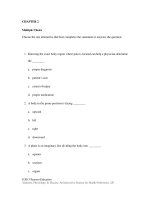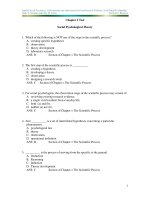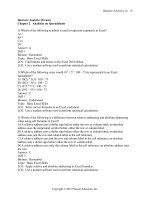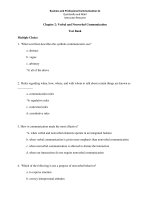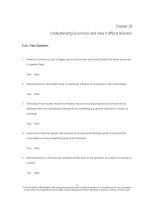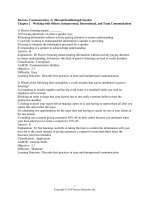Business and professional communication KEYS for workplace excellence 2nd edition quintanilla test bank
Bạn đang xem bản rút gọn của tài liệu. Xem và tải ngay bản đầy đủ của tài liệu tại đây (318.21 KB, 10 trang )
Business and Professional Communication 2e
Quintanilla and Wahl
Instructor Resource
Chapter 2: Verbal and Nonverbal Communication
Test Bank
Multiple Choice
1. What word best describes the symbols communicators use?
a. abstract
b. vague
c. arbitrary
*d. all of the above
2. Rules regarding when, how, where, and with whom to talk about certain things are known as
__________.
a. communication rules
*b. regulative rules
c. contextual rules
d. constitutive rules
3. How is communication made the most effective?
*a. when verbal and nonverbal elements operate in an integrated fashion
b. when verbal communication is given more emphasis than nonverbal communication
c. when nonverbal communication is allowed to dictate the interaction
d. when our interactions do not require nonverbal communication
4. Which of the following is not a purpose of nonverbal behavior?
a. to express emotion
b. convey interpersonal attitudes
Business and Professional Communication 2e
Quintanilla and Wahl
Instructor Resource
*c. replace verbal communication
d. present one's personality
5. John is giving a presentation at his office. During his speech, John controls his tone of voice,
how fast he is talking, and how he articulates his words. John is using the nonverbal code of
_________.
a. kinesics
b. proxemics
c. physical appearance
*d. vocalics
6. Stacy is studying in the library at her school when a stranger comes up and moves her
backpack to take the seat next to her. Stacy becomes uncomfortable and moves to another table.
This is a violation of _____________.
*a. proxemics
b. kinesics
c. space
d. a and c
7. The space that is generally occupied by significant others, family members, and close friends
is known as the ___________ zone.
a. social zone
*b. intimate zone
c. informal
d. casual
Business and Professional Communication 2e
Quintanilla and Wahl
Instructor Resource
8. A restaurant's decision to use intense colors, intimate seating arrangements, and bright
lighting are all examples of influencing ___________.
a. space
b. perceptions
*c. environment
d. kinesics
9. During a speech, Frank lost his footing and fell to the floor. To show the audience he was
okay, Frank gave a thumbs-up to the crowd. The thumbs-up is an example of a(n) ___________.
a. illustrator
*b. emblem
c. regulator
d. affect display
10. While Shawn is talking to a colleague about firings in the department, he notices his
coworker wringing her hands and fidgeting quite a bit, so he changes the subject. Shawn's
colleague is displaying ________.
*a. adapters
b. regulators
c. illustrators
d. emblems
11. Trying to keep a blank expression when hearing bad news would be an example of
________.
a. masking
b. deintensification
Business and Professional Communication 2e
Quintanilla and Wahl
Instructor Resource
*c. neutralization
d. concealing
12. Aaron is playing a game of poker with his friends when he gets a really good hand. He wants
to bait his opponent to make a bet, so he puts a sad look on his face to indicate he doesn't like his
hand. Aaron is using the strategy of __________.
a. intensification
*b. masking
c. deception
d. neutralization
13. Greeting a coworker with a handshake falls under the category of _________ touch.
*a. functional
b. social
c. friendship
d. acquaintance
14. Why is touch such an important nonverbal code?
a. it is the most commonly used code
b. touching is a taboo code in many cultures
c. touch conveys a great deal of information about our personality
*d. touch is the most powerful and misunderstood code
15. Joel's team was given a project that included the due date, meeting times, and people
involved in the project. This information forms the ________.
Business and Professional Communication 2e
Quintanilla and Wahl
Instructor Resource
a. relational layer
*b. content layer
c. verbal communication
d. environment
16. Success in productivity and sales has been linked to _________.
a. facial expressions
b. salesperson posture
c. handshake techniques
*d. all of the above
17. Journalists who receive low public respect and esteem have been found to commonly be
guilty of _________.
*a. arrogant body language
b. wordy dialogue
c. nervous body language
d. exaggerated gestures
18. What criteria do patients often use when selecting physicians?
a. medical schooling
b. proximity to their home
*c. perceived image
d. experience
Business and Professional Communication 2e
Quintanilla and Wahl
Instructor Resource
19. The level of performance and perceived satisfaction a teacher receives from their students is
largely influenced by __________.
a. verbal communication
*b. nonverbal communication
c. difficulty of course material
d. the peer relationship of the classroom
20. How can managers effectively convey impressions of empathy and power?
a. tone of voice
b. physical appearance
c. work environment
*d. body language
21. For a speaker to be consistently efficient at verbally conveying their intended meanings, they
must _________.
*a. understand that intended meanings may not be fully conveyed by a message because
of a variety of factors
b. use shared language that has a universal meaning
c. reiterate their message more than once to the recipient
d. constantly define what their words mean during an communication interaction.
22. Learning that eye contact counts as paying attention, or that kissing/hugging counts as
showing affection help define our ________.
a. communication rules
b. regulative rules
*c. constitutive rules
Business and Professional Communication 2e
Quintanilla and Wahl
Instructor Resource
d. interactive rules
23. Nonverbal communication accounts for ______% to _______% of the total meaning of
communication.
a. 23%, 47%
*b. 65%, 93%
c. 72%, 98%
d. 35%, 50%
24. The nonverbal dimension that defines how we react to things by evaluating them as
positive/negative or good/bad is known as _________.
*a. immediacy
b. responsiveness
c. status
d. proximity
25. Katherine is giving a speech to her boss tomorrow. To prepare, Katherine puts on her
conservative jewelry and makeup, her business suit, and a moderate perfume. These are known
as ________.
a. emblems
b. illustrators
*c. artifacts
d. affect displays
True/False
26. Eye contact is a constitutive rule than counts as paying attention.
Business and Professional Communication 2e
Quintanilla and Wahl
Instructor Resource
*a. True
b. False
27. Over half of interpersonal messages are conveyed nonverbally.
*a. True
b. False
28. Nonverbal communication cannot substitute part of a verbal message.
a. True
*b. False
29. Nonverbal cues can conflict with what is being said.
*a. True
b. False
30. Kinesics refers to how people use their voices to communicate and express themselves.
a. True
*b. False
31. The jewelry, tattoos, piercings, and makeup a person uses are known as emblems.
a. True
*b. False
32. Affect displays complement, enhance, or substitute for a verbal message.
Business and Professional Communication 2e
Quintanilla and Wahl
Instructor Resource
a. True
*b. False
33. A hug or pat on the back is an example of a social touch.
*a. True
b. False
34. Shared understanding of what communication means and what constitutes appropriate
communication are known as communication rules.
*a. True
b. False
35. Verbal communication does not carry any symbolic meaning or understanding.
a. True
*b. False
Essay
36. Discuss how you would alter you physical appearance between going to a concert or going
to a job interview. What do want your alterations to say about you in each of the different
contexts?
*a. Varies
37. Why do you think it is important to alter our facial expressions depending on the context of a
situation? Under what circumstances would it be inappropriate to show your true feelings during
an interaction?
*a. Varies
Business and Professional Communication 2e
Quintanilla and Wahl
Instructor Resource
38. How do your gestures and body movement impact a professional setting differently than an
informal or social setting?
*a. Varies
39. Think about an example where your space has been violated. What boundary or territory
markers did you set up around you? Why were they not effective?
*a. Varies
40. Discuss the appropriateness of touch in regards to a professional setting. Is there ever a
situation where it is appropriate to move beyond the functional/professional touch?
*a. Varies
41. Think about the last good presentation you have seen, whether it was professional, informal,
comedic, or dramatic. What methods did they use to effectively combine their verbal and
nonverbal communication?
*a. Varies

